[63] The King Apparelled Himself – A Blog about the Banners of Tewkesbury
I went to Tewkesbury and I noticed the banners in the streets.

I had seen some of these heraldic flags on previous visits and had assumed that they were random heraldic designs put up to make the town look mediaeval and attractive to tourists.
But as I went round the town this time the first ones I came to were this group of three banners in a little back street on old houses overlooking the river.



Each house had a little printed note, carefully enclosed in waterproof polythene, stuck prominently in their tiny gardens below the banners.



I could see that these banners had much more significance to the people of Tewkesbury. As I went round the town I was careful to photograph as many as I could and when I reached the Abbey I did a bit more investigating.
I looked in the Abbey shop and I found The Street Banners of Tewkesbury produced by the Tewkesbury Battlefield Society.
So I need to do a diversion here and go back a bit – back somewhat over 500 years!
The Battle of Tewkesbury
When we did History at school we did the Romans and then we skipped over the Dark Ages and Mediaeval England and we started again with the Tudors from 1485. So I know very little about the Wars of the Roses. They were long and complicated and I won’t begin to attempt to explain them.
But with the help of Wikipedia I can say that the Battle of Tewkesbury, which took place on 4 May 1471, was one of the decisive battles of the Wars of the Roses. The forces loyal to the House of Lancaster were completely defeated by those of the House of York under King Edward IV. The Lancastrian heir to the throne, Edward, Prince of Wales, and many prominent Lancastrian nobles were killed during the battle or were dragged from sanctuary (in Tewkesbury Abbey) two days later and executed. The Lancastrian king, Henry VI, a prisoner in the Tower of London, died or was murdered shortly after the battle. The Battle of Tewkesbury restored political stability to England at least until the death of Edward IV in 1483.
The Banners
For the last twenty years the Tewkesbury Battlefield Society has undertaken the task of producing and maintaining these banners, which are made individually by hand. Every May there is a public showing of new and refurbished banners at the Town Hall. Local shops and houses can choose them and hire them for erection in June. They come down in September to avoid the hazards of winter weather.
The book has short description of each of the people represented, with a picture of the banner and notes about genealogy and heraldry. I can’t include everything here so I will make some general comments and then show you the banners with comments on one or two.
Heraldry
These banners represent early heraldry with colourful designs on shields and armour to identify individual soldiers. Various stylized forms developed over hundreds of years with the pattern on the shield identifying the family. Differences were made for descendants of the original arm-bearers and this period is almost the end of the relatively uncontrolled era of heraldry. It was a few years later, in 1484, that the College of Arms was formed to register and formalize the process.
A modern armorial Achievement (colloquially known as a Coat of Arms) is not just the shield (Escutcheon) at its centre. It also generally includes a Crest on a Helmet with a Torse, Supporters at each side, Mantling and a Motto. But the banner of arms is a simple flag and shows just the shield.
When they hang vertically as those at Tewkesbury there is no distinction between right and left so you don’t have to worry about ‘dexter’ (right) and ‘sinister’ (left) meaning ‘left’ and ‘right.’ (Actors may perhaps understand the confusion of ‘stage right’ and ‘audience left.’) Some of the pictures below will only match their blazon if you flip the picture round.
Blazon
The art of describing these shields (Blazon) can fill books. (It does!) The descriptions are still in an archaic Norman French with word order not as we would speak today. I will give you two examples, one from each side. Note first that they don’t use white and yellow. For historic reasons they are silver and gold.

The first one is a very simple design and you will understand its blazon. Sir William Fielding of Lutterworth, Leicestershire (1428-71) fought on the Lancastrian side. His banner was:
Argent a fess Azure charged with three lozenges Or.
[Silver, with a bar across the middle, blue, bearing three diamond shapes, gold.]
The book tells you a little more about Sir William who was made Sherriff of Cambridgeshire and Huntingdon in 1470. He was killed in the battle at Tewkesbury.

Sir William Norreys of Bray and Yattendon, Berkshire (1440-1507) fought on the Yorkist side. His shield is more complicated with parts coming from his father and some from his maternal grandfather. Women didn’t bear arms in the same way as men but they could pass them on. His blazon is:
Quarterly
1 and 4. Argent a chevron between three raven’s heads sable
2 and 3. Quarterly Argent and Gules fretty Or a bend Azure charged with three bezants.
[Divided into quarters
Two of these quarters – each is silver with a chevron and three raven’s heads, all black.
The other two quarters are quartered again – silver and red with yellow diagonal lattices – over all a diagonal bar, blue, with three gold circles.]
I have tried to translate the blazons but you can see how they work very concisely. For example the word ‘bezant’ above is actually short for a ‘roundel Or,’ Roundels were so common that they each had a name. A bezant was a gold coin and hence a gold roundel but other roundels could be plates, hurts, torteaux, pellets, pommes, golpes, oranges or guzes depending on their colour. Even more concise was the word fountain for a ‘roundel barry wavy argent and azure,’ the very common blue and white stripy representation of water.
There will be another blog about Heraldic Signs.
The Lancastrians
These are in the same order as the book so you can find them yourself.


John Basset [Barry wavy of six Or and Gules] One of few surviving prisoners to be pardoned and allowed to return home to Cornwall.



Sir John Butler [Or a chief indented Azure] and Sir Thomas Butler [Or a chief indented Azure a molet Argent for difference] who later succeeded his brother as Earl of Ormond. The blazon makes it clear why these two are different. John was a second son and only had the banner without a difference mark because his older brother had been beheaded after an earlier battle.





Sir Thomas FitzHenry [Ermine a chief Azure charged with three lions rampant Or.] The Ermine of the blazon is neither a metal (like Argent and Or) nor a colour (like Azure or Sable) but it is a tincture representing fur. The fur is the white winter coat of a stoat with lots of small furs sewn together. Exaggerated stylized tails make the black patterns.


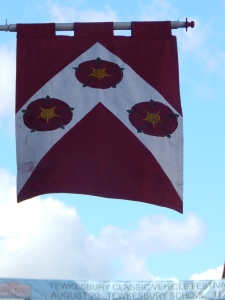




I’m sure you all spotted another pair of brothers there – Sir John and Sir Roger Lewkenor. (More to come below.)

They loved puns. Doctor Ralph Mackarell, a non-combatant Doctor of Divinity. [Azure three mackerels hauriant Argent.]





Margaret Valois of Anjou, Queen of England after her marriage to Henry VI, a major figure on the Lancastrian side, had a more complex banner described as Quarterly of six. (Quarterly did not necessarily have anything to do with a four-part division.) I won’t give the full blazon but two of the six sections were forms of the ancient shield of France (blue with gold fleu-de-lys) modified to represent Anjou and Lorraine and three of the others represented Hungary, Jerusalem and the Duchy of Lorraine.
She was captured just after the battle and held until the King of France paid her ransom of 50 000 crowns. As Queen of England she could have had an even more complicated banner impaling her arms with those of Henry VI.








 The Yorkists
The Yorkists
There were more Lancastrians than Yorkists but most of the banners represent Yorkists. Perhaps that is because they won!

This banner of Richard, Duke of Gloucester (later Richard III) is a household banner, not the same as his shield (a differenced version of the royal arms of his brother, Edward IV, shown further on.)





Sir Walter Blount, Lord Mountjoy of Thurveston, Barton Blount and Elvaston is one where my picture shows a reversed form. Among other changes this gets the numbers of the quarters wrong. It should be.
Quarterly
1 Argent two wolves Sable, on bordure Or eight saltires Gules
2 Or a castle triple towered Azure
3 Barry nebuly of six Or and Sable
4 Vair
Vair, like Ermine is a stylized form of fur, representing the greyish-blue backs of squirrels alternating with their white under-bellies. (It’s the winter fur of one form of the Red Squirrel found in northern Europe.)











This is not just a wolf. It has blood on its claws and tongue. It is Azure, a wolf salient Argent, armed and langued Gules.






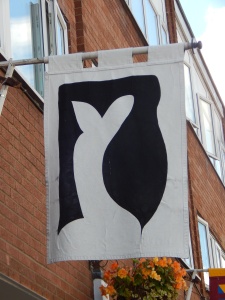

 King Edward IV, Duke of York (Edward Plantaganet,) the leader of the Yorkists. The banner is: ‘Quarterly 1 and 4. Azure three fleur-de-lys Or 2 and 3. Gules three lions passant guardant Or’ but its history is so well-known that it It’s also described as: ‘Quarterly 1 and 4 France 2 and 3 England.’
King Edward IV, Duke of York (Edward Plantaganet,) the leader of the Yorkists. The banner is: ‘Quarterly 1 and 4. Azure three fleur-de-lys Or 2 and 3. Gules three lions passant guardant Or’ but its history is so well-known that it It’s also described as: ‘Quarterly 1 and 4 France 2 and 3 England.’
The Royal Standard has changed little over hundreds of years. As I am sure you will recognize it is now Quarterly 1 and 4 England 2 Scotland 3 Ireland.


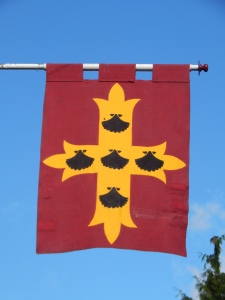









A very simple banner using counter-changing. Sir Geoffrey Poole of Worrell: Per pale Or and Sable, a saltire engrailed counter-changed.







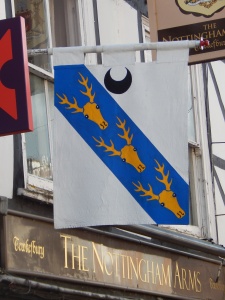





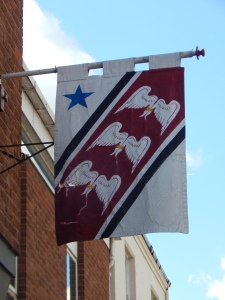

Unidentified Banners
The book is a few years old and I found a few new ones not in the book. Most of these seem to be very close relatives of some in the book, marked by small differences in the blazon.

Without the tree torteaux (roundels Gules) this would be the Lancastrian Sir Henry Grey.

Probably Sir Maurice Berkeley whose two sons fought with the Yorkists. They both have this banner with difference marks.

Probably Sir Philip Courtenay who also had two sons fighting for the Yorkists.

Perhaps a relative of the Lancastrian Sir Robert Knollys who had three red roses on a chevron instead of one on a saltire as shown above.

Fairly similar to the banner of Sir Thomas Montgomery, a Yorkist.

The Lancastrian John Wroughton had boar’s heads instead of greyhounds.
I won’t guess at the next two but the last one (which appears on the cover of the book, but not inside) is presumably the white rose of York.



It’s all about the Battle of Tewkesbury and the web-site of the Tewkesbury Battlefield Society displays this quotation which probably comes from a contemporary document.
The Kynge apparailed hymselfe, and all his hooste set in good array; ordeined three wards; displayed his bannars; dyd blowe up the trompets; commytted his caws and qwarell to Almyghty God, to owr most blessyd lady his mothar, Vyrgyn Mary, the glorious martyr Seint George, and all the saynts; and advaunced, directly upon his enemyes; approchinge to theyr filde, which was strongly in a marvaylows storng grownd pyght, full difficult to be assayled.
A similar description with more modern spelling is as follows.
Upon the morrow following, Saturday, the 4th day of May the king apparelled himself, and set all his host in good array, displayed his banners, did blow up the trumpets, committed his cause and quarrel to God, and advanced directly upon his enemies who were pitched strongly in a marvellously strong ground, very difficult to assail. In front of their field were such evil lanes and deep dikes, so many hedges, tree, and bushes, that it was very hard to approach near and come to hand fighting. But Edmund, called Duke of Somerset, having that day the vanguard advanced with his troops somewhat on one side of the king’s vanguard, and by certain paths and ways previously surveyed, and unknown to the king’s party, he departed out of the field, passed a lane, and came to a close, just in front of the king and from the hill that was in one of the closes, he set right fiercely on the end of the king’s division. The king, in manly fashion, at once set upon them won the dike and hedge and with great violence pushed them back up the hill, assisted by the Duke of Gloucester.

